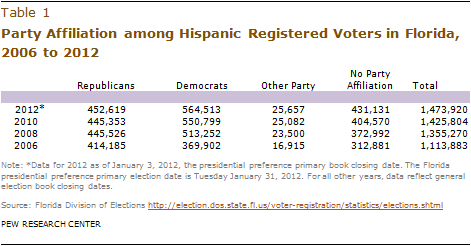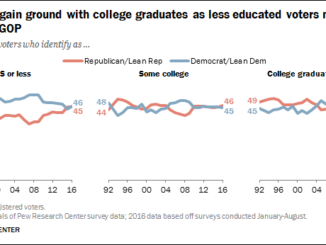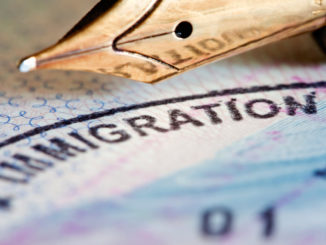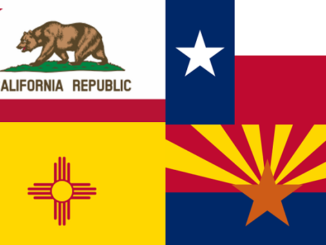
As the attention of the nation turns toward Florida ahead of its primary election, the Latino vote has emerged as an important factor.
For decades, Republican candidates could count on that vote to help them win elections in the Sunshine State, especially in the southern part of Florida where a strong Cuban-American community is a political force.
But a change has been brewing recently. “Sixty percent of non-Cuban Hispanics are Democrats,” said Florida International University Prof. Daniel Alvarez.
New data analyzed by the Pew Hispanic Center seems to confirm Alvarez’s statement. Based on figures from the Florida Division of Elections, registered Latino Democrats now outnumber registered Republicans.
There are 1,473,920 Hispanics registered to vote in Florida, representing 13.1% of all registered voters in the state. Of those, 452,619 are Republicans and 564,513 are Democrats.
Overall, Democrats have about 450,000 more registered voters that Republicans in Florida. Barak Obama won the state in 2008 by less than 200,000 votes.
According to the review, the partisan gap among Hispanics continues to grow in favor of the Democrats, a trend that began in 2008.
But Betina Inclan, the national director of Hispanic outreach for the Republican National Committee, is not concerned about the numbers. She notes that the fastest growth is among independent Hispanics.
“Even if they are deemed Democrats, we have seen that that doesn’t mean they are one party or the other. Latinos are looking for candidates that respect their values, respect their community and give them solutions,” Inclan said.
She said Republican Gov. Rick Scott was helped by Latino voters in the 2010 election, winning a slight majority of their votes. She also pointed to the election victory of Republican Sen. Marco Rubio in a three-way race.
According to the Pew Hispanic Center review of elections data, South Florida continues to be a stronghold of Republican-leaning Hispanics, with 58% of all Republican Latinos in Florida living in Miami-Dade County. Thirty-four percent of the state’s Latino Democrats live there.
Just north of Miami, in Broward County, Latino Democrats outnumber Republicans by roughly 30,000. Further north in Palm Beach County, the ratio is two Democrats for each Republican. In the counties around Orlando, the Democratic majority is even wider, with a difference of almost 3-1 in Volusia County.
Fabio Andrade, a Colombian-American Republican who co-chaired John McCain’s 2008 presidential campaign in Miami, says that when he tries to recruit newly settled Hispanics to register as Republicans, they tell him they identify with the core values of the party, but the message from its more conservative wing — especially on the illegal immigration issue — turns them off.
 According to the Pew analysis, Puerto Ricans make up 28% of the Hispanic population in Florida, making them the second-largest Hispanic group in the state after Cuban-Americans. Mexican-Americans, who account for 59% of the eligible Hispanic voters in the United States, make up only 9% of the Latino vote in Florida.
According to the Pew analysis, Puerto Ricans make up 28% of the Hispanic population in Florida, making them the second-largest Hispanic group in the state after Cuban-Americans. Mexican-Americans, who account for 59% of the eligible Hispanic voters in the United States, make up only 9% of the Latino vote in Florida.
Among the other findings by the Pew Hispanic Center:
— The Hispanic population in Florida is the third-largest in the nation. More than 4.2 million Hispanics reside there, representing 8% of all Hispanics in the United States. California has the largest Hispanic population, with Texas ranking second.
— Florida’s population is 23% Hispanic, the sixth-highest Hispanic population share nationally. New Mexico has the largest, with 42%.
— There are 2.1 million eligible Hispanic voters in Florida — the third-largest Hispanic eligible-voter population nationally. California ranks first with 5.9 million.
— Some 16% of Florida’s eligible voters are Hispanic, the fifth-largest Hispanic eligible-voter population share nationally. New Mexico ranks first with 39%.
— About one-half (49%) of the Hispanics in Florida are eligible to vote, ranking Florida 12th nationwide in the share of the Hispanic population that is eligible to vote. By contrast, 81% of the state’s white population is eligible to vote.
— Hispanic eligible voters in Florida are less likely to be native-born citizens (57%) than are Hispanic eligible voters nationwide (75%).




